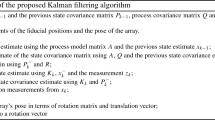Abstract
Purpose
Robot-assisted intraocular microsurgery can improve performance by aiding the surgeon in operating on delicate micron-scale anatomical structures of the eye. In order to account for the eyeball motion that is typical in intraocular surgery, there is a need for fast and accurate algorithms that map the retinal vasculature and localize the retina with respect to the microscope.
Methods
This work extends our previous work by a graph-based SLAM formulation using a sparse incremental smoothing and mapping (iSAM) algorithm.
Results
The resulting technique, “EyeSAM,” performs SLAM for intraoperative vitreoretinal surgical use while avoiding spurious duplication of structures as with the previous simpler technique. The technique also yields reduction in average pixel error in the camera motion estimation.
Conclusions
This work provides techniques to improve intraoperative tracking of retinal vasculature by handling loop closures and achieving increased robustness to quick shaky motions and drift due to uncertainties in the motion estimation.











Similar content being viewed by others
References
Weiss JN, Bynoe LA (2001) Injection of tissue plasminogen activator into a branch retinal vein in eyes with central retinal vein occlusion. Ophthalmology 108(12):2249–2257
Bynoe LA, Hutchins RK, Lazarus HS, Friedberg MA (2005) Retinal endovascular surgery for central retinal vein occlusion: initial experience of four surgeons. Retina 25:625–632
Rogers S, McIntosh RL, Cheung N, Lim L, Wang JJ, Mitchell P, Kowalski JW, Nguyen H, Wong TY (2010) The prevalence of retinal vein occlusion: pooled data from population studies from the United States, Europe, Asia, and Australia. Ophthalmology 117(2):313–319
Nambi M, Bernstein PS, Abbott JJ (2016) A compact telemanipulated retinal-surgery system that uses commercially available instruments with a quick-change adapter. J Med Robot Res 1(2):1630001
Nasseri MA, Eder M, Eberts D, Nair S, Maier M, Zapp D, Lohmann CP, Knoll A (2013) Kinematics and dynamics analysis of a hybrid parallel-serial micromanipulator designed for biomedical applications. In: Proceedings of the IEEE/ASME international conference on advanced intelligent mechatronics, pp 293–299
Wilson JT, Gerber MJ, Prince SW, Chen CW, Schwartz SD, Hubschman JP, Tsao TC (2018) Intraocular robotic interventional surgical system (IRISS): mechanical design, evaluation, and master-slave manipulation. Int J Med Robot Comput Assist Surg 14(1):e1842
Taylor R, Jensen P, Whitcomb L, Barnes A, Kumar R, Stoianovici D, Gupta P, Wang Z, Dejuan E, Kavoussi L (1999) A steady-hand robotic system for microsurgical augmentation. Int J Robot Res 18(12):1201–1210
Üneri A, Balicki MA, Handa J, Gehlbach P, Taylor RH, Iordachita I (2010) New steady-hand eye robot with micro-force sensing for vitreoretinal surgery. In: Proceedings of the 3rd IEEE RAS and EMBS international conference on biomedical robotics and biomechatronics, pp 814–9
Willekens K, Gijbels A, Schoevaerdts L, Esteveny L, Janssens T, Jonckx B, Feyen JH, Meers C, Reynaerts D, Vander Poorten E, Stalmans P (2017) Robot-assisted retinal vein cannulation in an in vivo porcine retinal vein occlusion model. Acta Ophthalmol 95(3):270–275
Yang S, MacLachlan RA, Riviere CN (2015) Manipulator design and operation for a six-degree-of-freedom handheld tremor-canceling microsurgical instrument. IEEE ASME Trans Mechatron 20(2):761–772
MacLachlan RA, Riviere CN (2009) High-speed microscale optical tracking using digital frequency-domain multiplexing. IEEE Trans Instrum Meas 58(6):1991–2001
Yang S, Martel JN, Lobes LA Jr, Riviere CN (2018) Techniques for robot-aided intraocular surgery using monocular vision. Int J Robot Res 37(8):931–952
Mukherjee S, Yang S, Maclachlan RA, Lobes LA, Martel JN, Riviere CN (2017) Toward monocular camera-guided retinal vein cannulation with an actively stabilized handheld robot. In: Proceedings of the IEEE international conference on robotics and automation, pp 2951–2956
Becker BC, Riviere CN (2013) Real-time retinal vessel mapping and localization for intraocular surgery. In: Proceedings of the IEEE international conference on robotics and automation, pp 5346–5351
Braun D, Yang S, Martel JN, Riviere CN, Becker BC (2018) EyeSLAM: real-time localization and mapping of retinal vessels during intraocular microsurgery. Int J Med Robot Comput Assist Surg 14:e1848
Olson EB (2009) Real-time correlative scan matching. In: Proceedings of the IEEE international conference on robotics and automation, pp 4387–4393
Dellaert F, Kaess M (2017) Factor graphs for robot perception. Found Trends Robot 6(1–2):1–139
Kaess M, Johannsson H, Roberts R, Ila V, Leonard JJ, Dellaert F (2012) iSAM2: Incremental smoothing and mapping using the Bayes tree. Int J Robot Res 31(2):216–235
Engel J, Sturm J, Cremers D (2013) Semi-dense visual odometry for a monocular camera. In: Proceedings of the IEEE international conference on computer vision, pp 1449–1456
Engel J, Schöps T, Cremers D (2014) LSD-SLAM: large-scale direct monocular SLAM. In: Proceedings of the European conference on computer vision, pp 834–849
Lowe DG (1999) Object recognition from local scale-invariant features. In: Proceedings of the international conference on computer vision, vol 2, pp 1150–1157
Bay H, Ess A, Tuytelaars T, van Gool L (2008) Speeded-up robust features (SURF). Comput Vis Image Underst 110(3):346–359
Can A, Shen H, Turner JN, Tanenbaum HL, Roysam B (1999) Rapid automated tracing and feature extraction from live high-resolution retinal fundus images using direct exploratory algorithms. IEEE Trans Inf Technol Biomed 3(2):125–138
Newman P, Ho K (2005) SLAM-loop closing with visually salient features. In: Proceedings of the IEEE international conference on robotics and automation, pp 635–642
Acknowledgements
This study was partially funded by the U.S. National Institutes of Health (Grant No. R01EB000526). This article does not contain any studies with human participants or animals performed by any of the authors.
Author information
Authors and Affiliations
Corresponding author
Ethics declarations
Conflict of interest
The authors declare that they have no conflict of interest.
Rights and permissions
About this article
Cite this article
Mukherjee, S., Kaess, M., Martel, J.N. et al. EyeSAM: graph-based localization and mapping of retinal vasculature during intraocular microsurgery. Int J CARS 14, 819–828 (2019). https://doi.org/10.1007/s11548-019-01925-1
Received:
Accepted:
Published:
Issue Date:
DOI: https://doi.org/10.1007/s11548-019-01925-1




